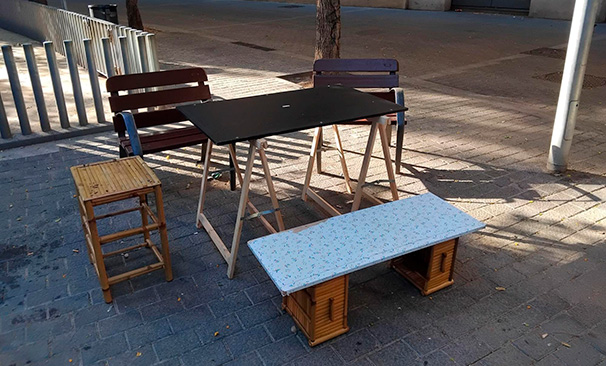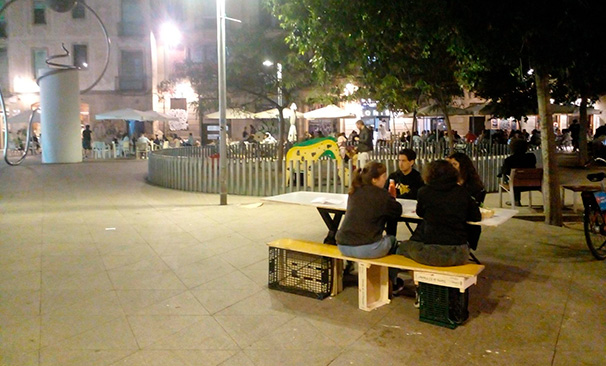What are you looking for?
You might be looking for...
MESA
Laboratori de calle

One of the interests of the street laboratory is to investigate ways of establishing a place (occupied space) and the possibilities of overflowing and/or displacing institutional landmarks.
Following the framework that gave rise to this research group during the Utopia Rambles exhibition, our base point of work would be to install a table in the urban space and test its permeability with spaces and people.
We understand that the table, once installed and occupied, provokes a spatial re-dimensioning and generates other possibilities of inhabiting the urban space. Thus, we visualise it as an open place for the creation of relationships, an invitation to encounter, a mystery (what are you doing here, what is this?) capable of generating temporary autonomous zones in which the ways of inhabiting space are simultaneously a topic for reflection and invention.
At the same time, it is clear to us that this same material platform, like its borders, produces a division, limits a space and generates a heterotopia of its own. So our main concern at the beginning of this process, in addition to thinking about the types of performative proposals we will be proposing in some specific spaces in Ciutat Vella, was to define the materials, practicality and design of this table. Because its own material form could initially generate an effect contrary to our intentions, provoking relationships with people and urban aesthetics that are not very permeable.
With this concern in mind, we created a table design that could be integrated with urban furniture and equipment, whose design would not present itself as an ‘object’ table, that would not reproduce the aesthetics of Nordic minimalism, which combines ecological concern with an aesthetic finish quite particular to institutional quality expectations. We thought that the table should be able to blend in with the tables in the bars, that it could be easily integrated into the landscape. This table should also be dismountable, easily transportable, foldable, wheeled or light.
We consulted people, collectives, cooperatives, we passed on our needs and asked for quotes. The prices we received were up to 10 times more than the purchase of a normal table. We would spend an exorbitant amount of money to produce a table that seemed precarious and ordinary, reproducing logics that generated an intense ethical dilemma for us.
If we wanted the table to be a relational, open device, it would have to be unfinished; if it is permeable, it would have to be mutant.
We decided to dedicate two of our meetings to test a methodological procedure to solve the table dilemma: we went out into the streets to see what possible types of tables the city had to offer armed with hammer and nails, two folding chairs and four trestles.
These two tests were decisive. They allowed us to understand the simplicity and efficiency of such a practice. In the first session, we built several tables out of junk found in the streets surrounding Santa Mònica and inhabited them for a while, observing the interactions generated with the environment. In the second session, we found the necessary material in the same street and went to the nearest square. We set up the table and held our working meeting there.
It is our conviction that this procedure of constructing tables in situ is the most ethical and most appropriate way of providing this object, this place of invitation. For these reasons, we wish to adopt this practice as part of the methodology of our research group.
Project promoted by the research group Laboratori de calle (Cecilia Vieira, Élise Moreau, Lautaro Reyes, Luana Raiter and Rafael Frazão)


